
The Blue Mountains are a mountainous region and a mountain range located in New South Wales, Australia. The region is considered to be part of the western outskirts of the Greater Sydney area. The region borders on Sydney's main metropolitan area, its foothills starting about 50 kilometres (31 mi) west of centre of the state capital, close to Penrith. The public's understanding of the extent of the Blue Mountains is varied, as it forms only part of an extensive mountainous area associated with the Great Dividing Range. As defined in 1970, the Blue Mountains region is bounded by the Nepean and Hawkesbury rivers in the east, the Coxs River and Lake Burragorang to the west and south, and the Wolgan and Colo rivers to the north. Geologically, it is situated in the central parts of the Sydney Basin.

Katoomba is the main town and council seat of the City of Blue Mountains in New South Wales, Australia, and is the administrative centre of Blue Mountains City Council. Katoomba is located on the lands of the Dharug and Gundungurra Aboriginal peoples.

The Blue Mountains National Park is a protected national park that is located in the Blue Mountains region of New South Wales, in eastern Australia. The 267,954-hectare (662,130-acre) national park is situated approximately 80 kilometres (50 mi) west of the Sydney CBD, and the park boundary is quite irregular as it is broken up by roads, urban areas and areas of private property. Despite the name mountains, the area is an uplifted plateau, dissected by a number of larger rivers. The highest point in the park is Mount Werong at 1,215 metres (3,986 ft) above sea level; while the low point is on the Nepean River at 20 metres (66 ft) above sea level as it leaves the park.

The Jamison Valley forms part of the Coxs River canyon system in the Blue Mountains of New South Wales, Australia. It is situated approximately 100 kilometres west of Sydney, capital of New South Wales, and a few kilometres south of Katoomba, the main town in the Blue Mountains.

Springwood is a town in the Blue Mountains, New South Wales, Australia. Springwood is located 72 kilometres west of the Sydney CBD in the local government area of the City of Blue Mountains. At the 2021 census, Springwood had a population 8,423 people.
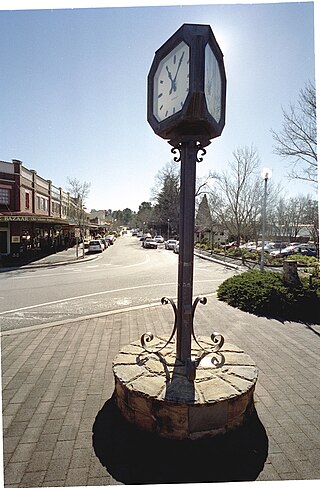
Wentworth Falls is a town in the Blue Mountains region of New South Wales, situated approximately 100 kilometres (62 mi) west of the Sydney central business district, and about 8 kilometres (5.0 mi) east of Katoomba, Australia on the Great Western Highway, with a Wentworth Falls railway station on the Main Western line. The town is at an elevation of 867 metres (2,844 ft) AHD. At the 2016 census, Wentworth Falls had a population of 6,076.
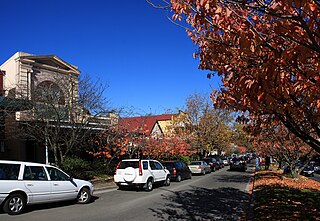
Leura is a suburb in the City of Blue Mountains local government area that is located 100 kilometres (62 mi) west of the Sydney central business district in New South Wales, Australia. It is one of the series of small towns stretched along the Main Western railway line and Great Western Highway that bisects the Blue Mountains National Park. Leura is situated adjacent to Katoomba, the largest centre in the upper mountains, and the two towns merge along Leura's western edge.

Katoomba railway station is a heritage-listed railway station located on the Main Western line in Katoomba, New South Wales, Australia. It serves the Blue Mountains town of Katoomba opening on 2 February 1874 as Crushers, being renamed Katoomba on 9 July 1877.
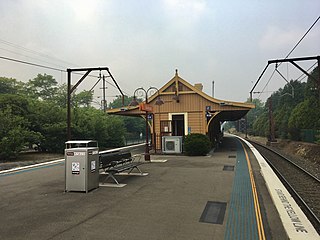
Blackheath railway station is a heritage-listed former railway bridge and now railway station located on the Main Western line in Blackheath in the City of Blue Mountains local government area of New South Wales, Australia. It was designed and built by NSW Government Railways and built from 1897 to 1985. It is also known as the Blackheath Railway Station Group. The property was added to the New South Wales State Heritage Register on 2 April 1999. The station opened on 28 December 1869.
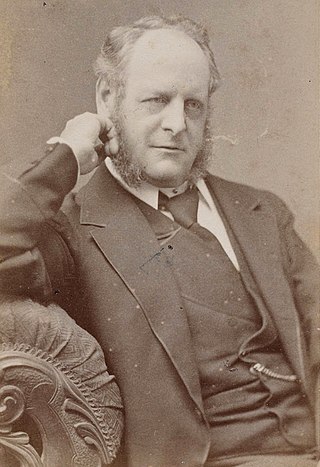
Sir Frederick Matthew Darley was the sixth Chief Justice of New South Wales, an eminent barrister, a member of the New South Wales Parliament, Lieutenant-Governor of New South Wales, and a member of the British Privy Council.

St Patrick's Seminary, Manly is a heritage-listed former residence of the Archbishop of Sydney and Roman Catholic Church seminary at 151 Darley Road, Manly, Northern Beaches Council, New South Wales, Australia. The property was also known as St Patrick's Estate, St. Patricks Estate, St. Patrick's Seminary or College, Cardinal's Palace, Archbishop's Residence, St Pats, St Patricks and Saint Paul's Catholic College. It was designed by Sheerin & Hennessy, Hennessy & Hennessy, Scott Green & Scott and Sydney G Hirst & Kennedy and built from 1885 to 1889 by William Farley (Residence/Palace), W. H. Jennings (College/Seminary). The property is owned by the Catholic Archdiocese of Sydney. The property was added to the New South Wales State Heritage Register on 21 January 2011.

Leuralla is a historic house in Leura, a suburb in the Blue Mountains, in New South Wales, Australia. It was the location of the Leuralla Toy & Railway Museum, which closed in 2022.
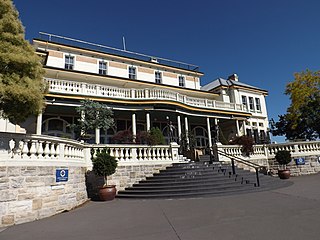
The Carrington Hotel is a heritage-listed former spa, hotel and power station and now hotel and public bar located at Katoomba Street, Katoomba in the Blue Mountains region of New South Wales, Australia. It was designed by John Kirkpatrick and Bosser in 1882; and by Edward Hewlett Hogben with Goyder Brothers in 1911–13; and built from 1882 to 1913 by F. Drewett in 1882; and by Howie, Brown and Moffit in 1912–13. It is also known as Great Western Hotel. The property is privately owned. It was added to the New South Wales State Heritage Register on 2 April 1999.

Bethungra is a large stone house in Sydney, Australia. It is heritage-listed, and was at one time used as a convent, but now a private residence. The house is located at 9 Fore Street, Canterbury, New South Wales. It was designed by Varney Parkes and built during 1896. It was added to the New South Wales State Heritage Register on 2 April 1999.

Rosebank is a heritage-listed former residence and boarding school and now offices at 17 Speed Street, Liverpool, Sydney, New South Wales, Australia. It was designed by Varney Parkes and built from 1882 to 1883. It is also known as Queens College. The property is owned by Liverpool City Council. It was added to the New South Wales State Heritage Register on 27 May 2005.

Woodford Academy is a heritage-listed former academy school, inn, private residence and boarding house and now a museum, and tourist attraction at 90-92 Great Western Highway, Woodford in the City of Blue Mountains local government area of New South Wales, Australia. It was built from 1828 to 1835 by Thomas Michael Pembroke. It is also known as Woodman's Inn, King's Arms Inn, Buss's Inn, Woodford House and Woodford Academy. The property is owned by the National Trust of Australia (NSW). It was added to the New South Wales State Heritage Register on 1 March 2002.

The Paragon Cafe is a heritage-listed restaurant located at 65 Katoomba Street, Katoomba, New South Wales, Australia. It was designed in successive stages by Harry & Ernest Sidgreaves shopfitters, architects Harry Lindsay Blackwood and George Newton Kenworthy, with decoration by Otto Steen, and built from 1909 to 1940. It is also known as Paragon Restaurant or simply The Paragon. It was added to the New South Wales State Heritage Register on 5 March 2015.
Cox's Cottage is a heritage-listed pasturing land and residence located at 2 St Thomas Road in the western Sydney suburb of Mulgoa in the City of Penrith local government area of New South Wales, Australia. It was built from 1810 to 1811 by James King. It is also known as Mulgoa Cottage; The Cottage, Coxs Cottage, and was formally known as Fern Hill and Estate of Mulgoa before the new house was built. The property remains privately owned and is the oldest house in Australia still in residence. It was added to the New South Wales State Heritage Register on 2 April 1999.

Iona is a heritage-listed residence and former private hospital located at 2 Darley Street in the inner city Sydney suburb of Darlinghurst in the City of Sydney local government area of New South Wales, Australia. It was built from 1880 to 1888. It is also known as Iona Cottage, while the private hospital was variously known as Wootton, Winchester and Hughlings. It was added to the New South Wales State Heritage Register on 2 April 1999.

Katoomba House is a heritage-listed residence at 81 Kent Street, in the inner city Sydney suburb of Millers Point in the City of Sydney local government area of New South Wales, Australia. It is also known as Seaforth House. It was added to the New South Wales State Heritage Register on 2 April 1999.


























